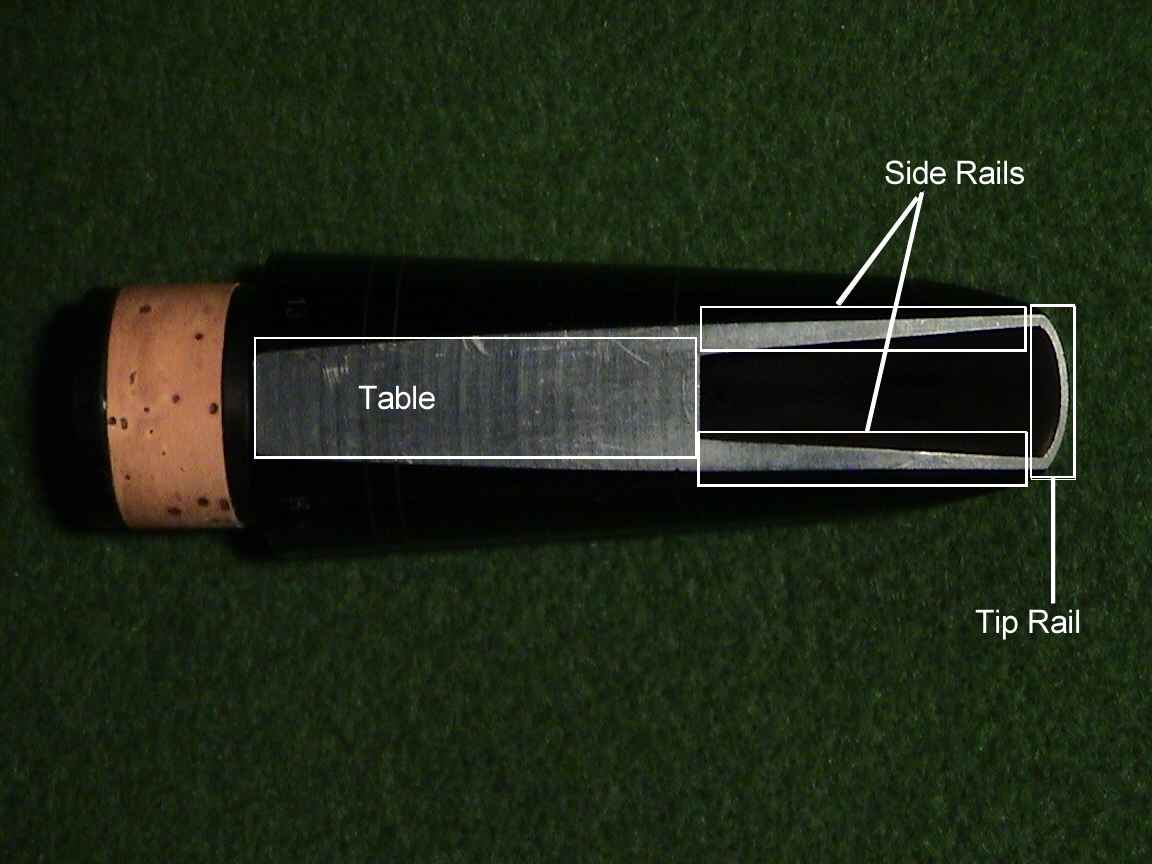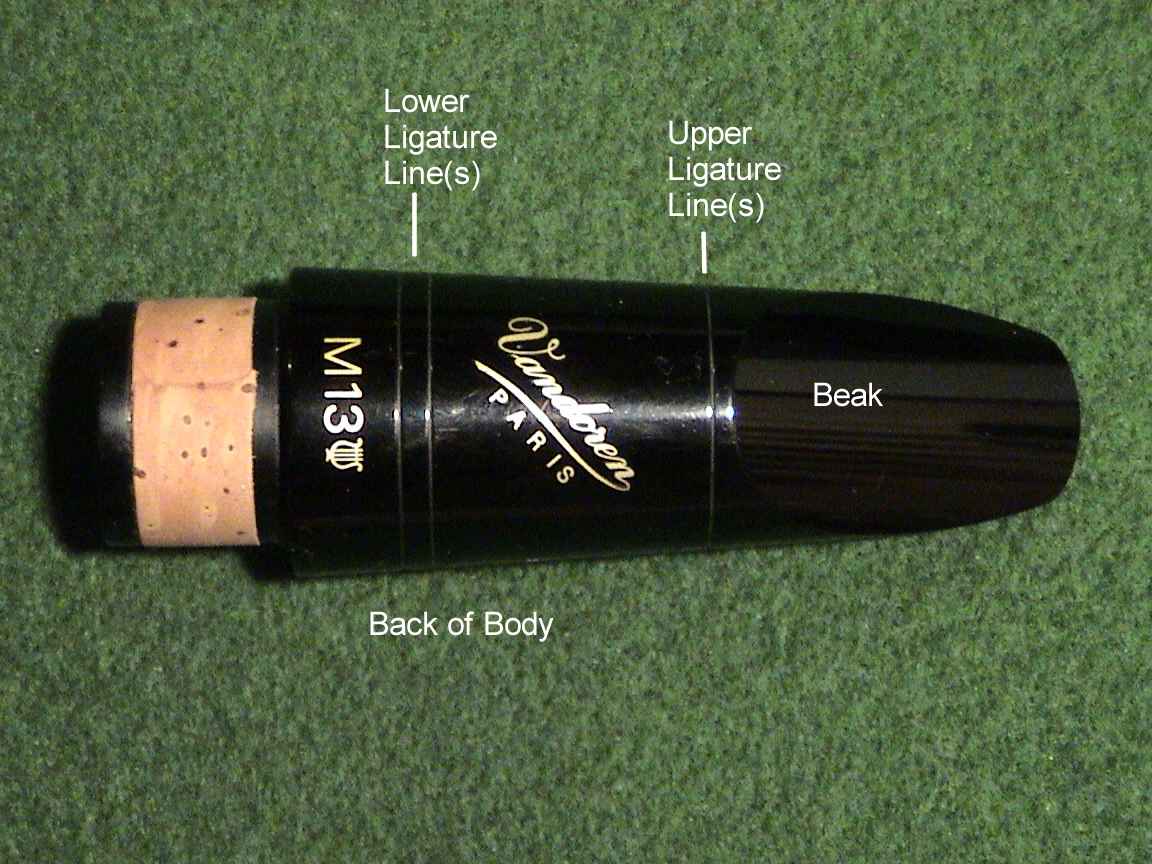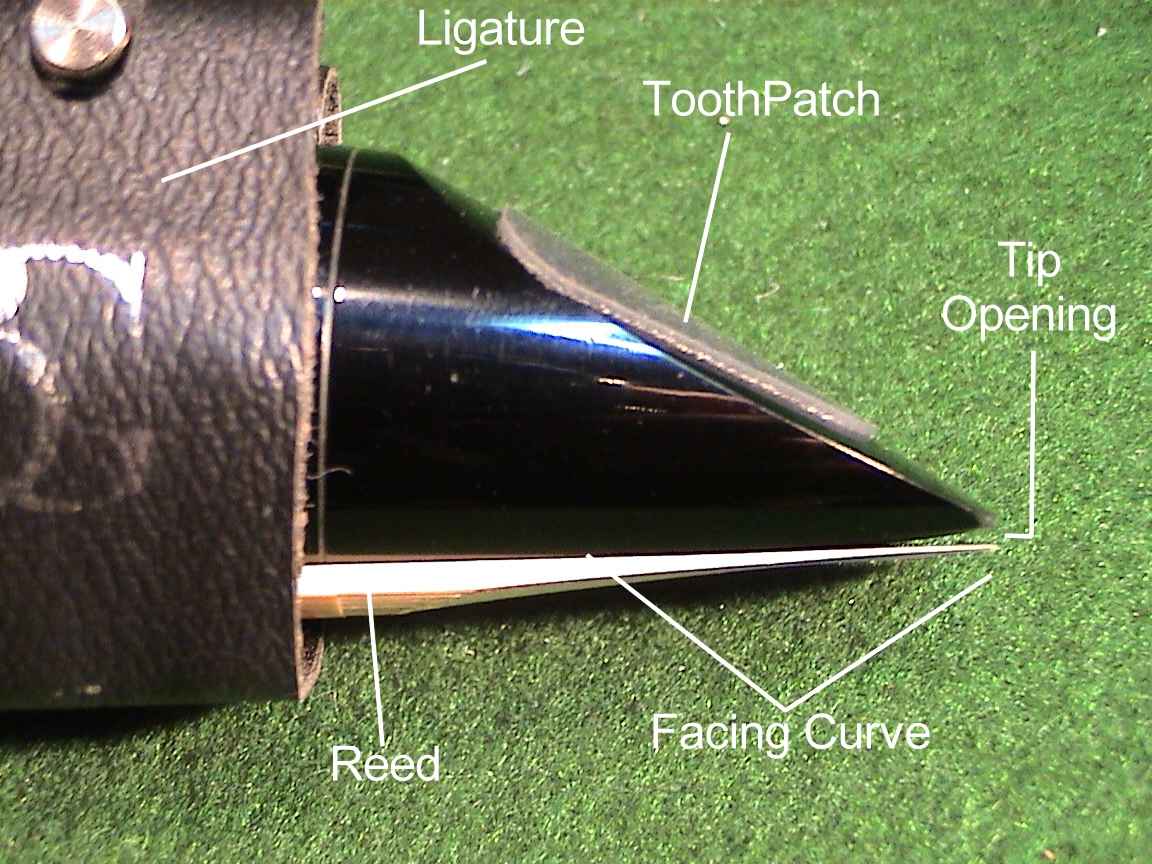[Mouthpiece Nomenclature]
[Mouthpiece Differences and How to Play Them
Correctly]

Tip Rail – the Tip Rail is at the very tip of the
mouthpiece. It is curved, the approximate same shape as the tip of a
reed.
Side Rails – The Side Rails are designed as a curve from the table
to the tip rail. Side rails are best when they represent a nice smooth
arc. Playing and response problems can occur when these rails are uneven
to each other or do not represent a nice smooth arc.
Table – The table is the flat part that the reed is placed on.
Table that are perfectly flat are preferred. Table with concave
sections can also be preferred but one must not over tighten a ligature as
this will create issues with the reed curving away from the rails.
Window – the opening between the Table, Rails and Tip Rails. A longer,
narrower window creates and even, balanced resistance. There are various shapes
dependent upon design intent.

Beak – the angled portion of the mouthpiece that you insert into your
mouth
Ligature Lines – Identified as the optimal place to put a ligature by
lines on the Body. Place the ligature in between these lines.

Ligature – The device that holds the reed to the mouthpiece
Toothpatch – a rubber patch that is placed on the top of the beak.
This allows a comfort for the teeth and protects the beak.
Reed – Cane or Synthetic material
Tip Opening – The size of the tip opening.
Facing Curve – This is the side rails as they curve away from the
table. They can vary per the overall length dependent upon the design of the
mouthpiece. The more the curve the larger the tip opening. Over time
a player’s reeds may bend and make the tip opening smaller than what it was
designed for (the reason to always take the reed off of the mouthpiece and place
on a flat glass or reed holder). This is also the case of the player’s
embouchure is too close to the tip of the mouthpiece – they will essentially
close down the tip opening more than normal.
How to Identify how to play a Mouthpiece
(a lesson on how they vary and how to vary your embouchure)
In general, there are certain specifications which will make mouthpieces play
a particular way (excluding the internal design), the following basic information is provided to assist in
understanding that information. This is general information, it may not be
specific to a specific mouthpiece as designs vary to overcome certain
limitations, etc.
There are 3 important items to a mouthpiece: [1] Facing Length; [2] Tip Opening;
and [3] Your Embouchure
| FACINGS – a Table Facing is the length and shape of the “curve” that occurs from the table to the tip. The facings helps define the Tip Opening.In General, the shorter the facing curve the quicker the reed responds, therefore quick notes are easier to play. But, in general, lower tonal qualities are also affected and become not as sonorous as a Medium facing. Whereas, in general, a long facing has excellent low note tonal qualities but mouthpieces are slow to respond. Thus, in general, the best for most players is a medium facing. |
|
Facing Length |
Approximate Length |
| Short | 15 millimeter (0.59 of an inch) |
| Medium Short |
16 mm (0.629 “) |
| Medium | 17 mm (0.669 “) |
| Medium Long |
18 mm (0.708 “) |
| Long | 19 mm (0.748 “) |
| Very Long |
20 or greater (0.787 “) |
| TIP OPENINGS – The Tip Opening is the amount of distance from the tip of the reed to the tip of the mouthpiece.In General, the larger the tip the softer the reed that is used. This is also dependent upon the Facing Length. Manufacturers will use a variety of combinations of long facings and large tips to short facings and large tips, or any variety to obtain a certain response and flexibility. Reeds also play an important factor. |
|
| Tip Definition |
Approximate Opening |
| Very Closed |
0.95 mm (0.037 of an inch) |
| Closed | 1.00 mm (0.039 “) |
| Medium Close |
1.05 mm (0.041 “) |
| Medium | 1.10 mm (0.043 “) |
| Medium Open |
1.15 mm (0.045 “) |
| Open | 1.20 mm (0.047 “) |
| Very Open |
1.25 mm (0.049 “) |
Extremely Open |
1.30 or greater (0.051″) |
| Embouchure – Why do I list the Embouchure in regards to mouthpieces? Basically, in order to obtain the “most” from a mouthpiece your embouchure has to take into account the Facing Length. If your embouchure does not then you are basically using a mouthpiece that is vastly different from what is is designed for.For example, if your embouchure lower lip was always at the 12mm mark then no matter the Facing Length you are going to close up the reed to the 12mm mark (or you will get air leaks after your embouchure) no matter if you are using a mouthpiece with a very long facing of 20mm or a short facing of 15 mm. This is basically shortening the Facing Length and Closing the Tip Opening because as you tighten your embouchure the reed is closing on the “curve” of the Facing Length and the tip opening is thus decreasing. So in essence you are “choking” the sound. Your embouchure would make most For example, let us assume that in order to use the A quick test to determine a Facing Length is to use a piece of paper, |